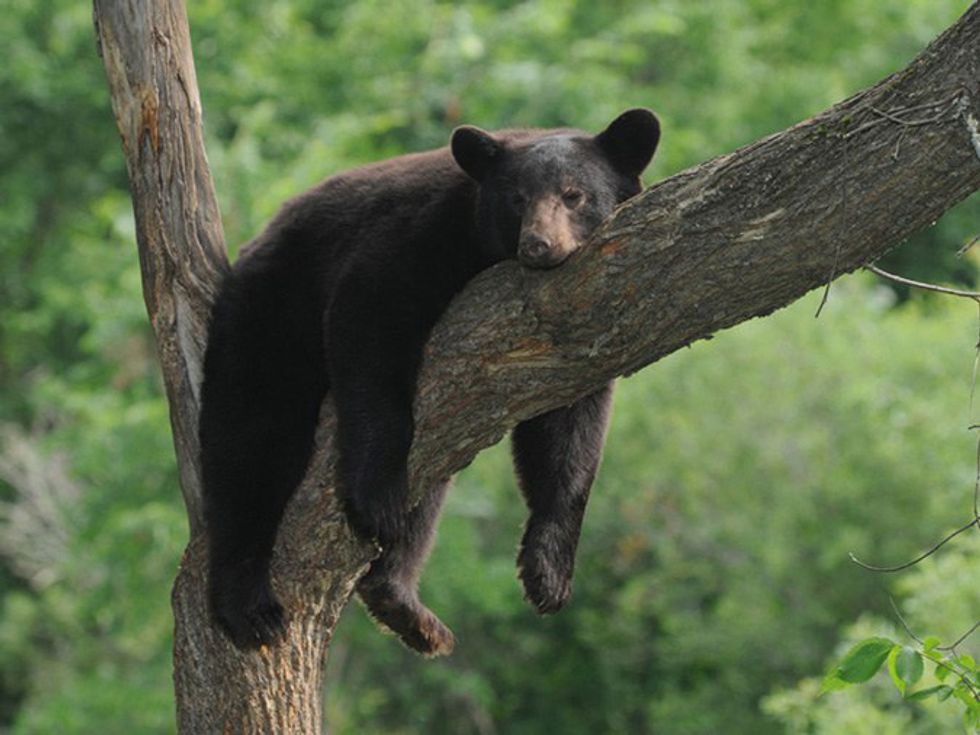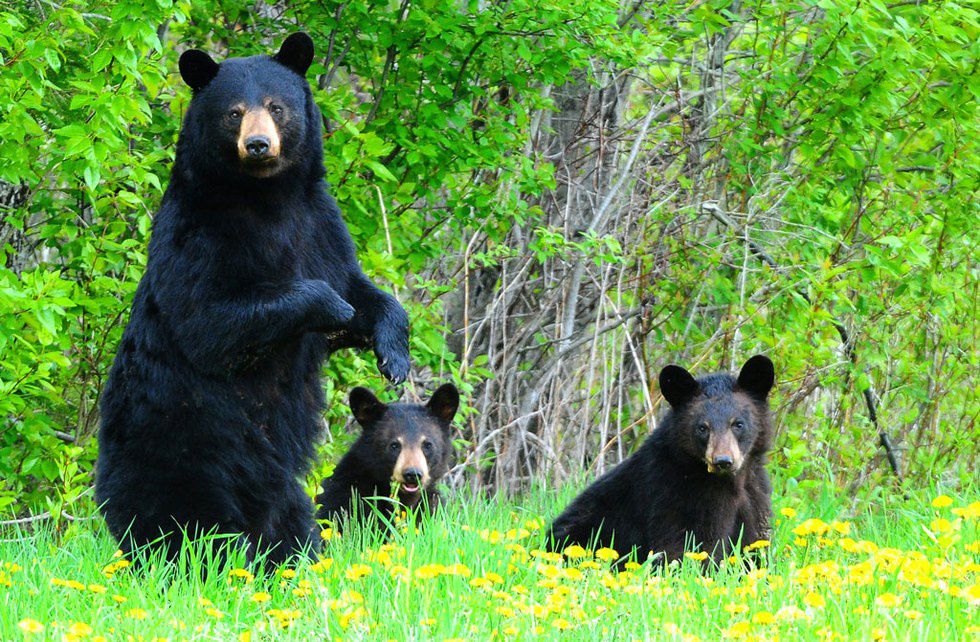You’ve probably heard “save the tigers,” “save the pandas,” and “save the rhinos,” but this might be the first time you’re hearing a plea to “save the black bears.” True, black bears are not considered an endangered animal at large, but here in New Jersey, they are at least in danger, if not completely endangered.
In 2010, the ever-popular Governor Chris Christie (that was sarcasm) resumed an annual bear hunt in the name of population control. If you were to accept what the media tells you without doing the research yourself, you would probably agree that keeping supposedly dangerous animals at bay in the most densely populated state in the country makes total sense. Perhaps having a bear hunt every few years would actually make sense – but the yearly hunt has claimed the lives of more than 3000 bears in the six years it has occurred, including a record-breaking 636 bears in 2016 alone. 3000 bears.
I literally didn’t even know New Jersey had 3000 bears. I’ll get back to that later.
Alright, so why is this a problem? Let me explain.
Now I don’t profess to be a bear expert myself, but I have lived in a semi-rural area for the past twelve years, and in that time I’ve only ever seen four bears in a residential area. Sure, I’ve seen bears in the woods – but that’s where they belong (and at that, I’ve still only seen about three in the past decade). So if the object of the bear hunt is to prevent bears from harming people, we should really only be concerned with the bears that are actually around people, and at least from my experience, that number is pretty darn low.
And why do bears go into residential neighborhoods in the first place? Well, the tree-hugger, hippie-dippie (but still true) reason would be that the bears were here first. We moved into their territory, and now we are stuck co-existing in the same area. You can’t really blame bears who have lived in a region for generations for continuing to live in that region, just because you decided to build a McMansion there.
But perhaps the more practical reason bears come into residential areas is actually preventable. Bears are hungry, and your garbage is a bear buffet. When you leave your garbage outside for the taking, the bears are attracted to your neighborhood. That’s not to say that a bear could never possibly come into a neighborhood without garbage, but leaving your garbage out for extended periods of time certainly increases the chances. Simply waiting to put your garbage out until the morning it gets collected would drastically decrease your chances of a visit from a bear.
If the argument is all it takes is one bear to cause you harm, then let’s examine the potential threat. We tend to associate bear behavior with the behavior specifically of grizzly bears, which doesn’t always apply to black bears. Did you know that black bears are flighted animals? That means when given the choice between fight or flight, they are way more likely to choose flight – usually by running up a tree. In fact, the long claws black bears have are not meant for attacking prey but meant for helping them climb. This even happens when it’s a mother and cubs (not only is this a fact from Bear Education and Resource, but I’ve witnessed it firsthand). Grizzly bears may defend their young in an aggressive manner, but black bear mothers are still more likely to run away. Black bears also tend to “bluff” rather than actually fight. They might slap the ground, snort or clack their jaws, or even charge a short distance before fleeing in an attempt to scare someone away. And remember, black bears are omnivores who tend to lean more vegetarian, they are not out on the hunt in search of humans to eat.
This is not to say that black bears aren’t dangerous. But the fact of the matter is, any animal can be dangerous under the right circumstances. Bear expert Lynn Rogers, Ph.D. of the North American Bear Center says you are 45 times more likely to be killed by a dog, 120 times more likely to be killed by bees, and 60,000 times more likely to be murdered by another human being, than to be killed by a black bear.
So by now you’re probably remembering the headline that took over the news back in 2014, when a 22-year-old Rutgers University student, Darsh Patel, was killed by a black bear in West Milford, New Jersey. This incident is no doubt a tragedy, and my heart goes out to everyone who was affected by it. But something that is important to remember about this incident is that it took place in the woods of West Milford’s Apshawa Preserve. It did not happen on a residential street, on a playground, in a schoolyard. It happened in the woods – where bears live, among other dangerous wildlife like snakes, coyotes, and hey, even rabid raccoons for that matter. Much the same way you need to consider ways to protect yourself when heading into a dangerous city area, you need to understand the potential threat you face when entering the woods and take the necessary precautions.
It is also important to note that Patel’s death was the first-ever confirmed instance of a human being killed by a bear in New Jersey in all of the state’s recorded history. Authorities even considered the attack to be “one in a million.”
My mother has always been against the bear hunts, but to be honest, I never thought about it much myself until a billboard appeared on State Route 10 last year on what was then my daily commute. The billboard featured a lion and a bear with the caption, “They Are All Cecil.” I’m sure you remember the huge public outrage over the trophy hunting of Cecil the Lion that took over Facebook newsfeeds and every television station in 2015. I too was horrified at the news and solicited my friends to sign a petition against such hunts. It wasn’t until I saw this billboard that I realized killing bears in these numbers was no different than the African hunts I was protesting.
Which brings me back to the numbers. I mentioned earlier that more than 3000 bears have been killed since the annual bear hunt came about in 2010. That is a number cited from NJ.com in an article published on December 10, 2016. However, while doing research for this piece I came across an earlier NJ.com article from November 2014 which states that the New Jersey bear population, after being almost completely wiped out in the 1960’s, rebounded to a population of about 2500 bears as recently as two years ago.
Hold up. Two years ago, we had 2500 bears.
We’ve killed over 3000 in the past six years.
Those numbers raise a red flag to me. They suggest that bears must be reproducing pretty fast for us to be killing so many in the name of “population control.”
So let’s talk about black bear reproduction. Did you know that black bear cubs, in addition to being adorable, fluffy balls of cuteness, stay with their mothers for a full two years? That means individual black bears only reproduce every two years, at the least. I’m no mathematician, but to me it seems we would need way more bears, reproducing way faster, to justify an annual bear hunt on this scale just to keep the population under control.
And how exactly do these bear hunts work? According to the New Jersey Division of Fishing and Wildlife, this year’s bear hunt consisted of two segments. The first segment ran from October 10-12, and the second from December 5-10. It allowed firearms…and bowhunting.
Bowhunting. This was the first time in 40 years New Jersey allowed the bowhunting of bears. I can only imagine how many arrows you would need to take down a bear, and how much pain that animal would be dealing with in the process.
In fact, in a 2002 article from taken from "Do-It-Yourself Black Bear Baiting and Hunting" by Dr. Ken Nordberg, it is described in a pretty chilling narrative (and guide) exactly what happens when you hunt a bear. He says the confused bear probably has “no idea what happened,” “blood loss and shock will eventually take their toll” after the shooting, and that you should “never begin trailing a shot black bear until ten minutes have passed,” implying that these bears can go at least ten minutes in horrific pain before finally dying. So much for thinking these are quick, clean deaths.
Need more reason to think this is outrageous? Meet Pedals, the injured bipedal bear that stole New Jersey’s hearts after residents in Oak Ridge, NJ spotted him casually strolling through neighborhoods on his hind legs in 2014. Nicknamed “Pedals” for his odd way of walking, the bear already had suffered injuries likely from being hit by a car which forced him to walk on his hind legs. Pedals was a sensation, and people couldn’t wait to catch of glimpse of the calm, seemingly docile bear. Social media accounts were started for him, and he even was featured on "Inside Edition."
Notice I wrote that in past tense? That’s because Pedals was killed this year during the bear hunt, shot down by a hunter during the bowhunting portion. After 310,000 people signed a petition to put Pedals in a sanctuary and raised $23,000 to build such an enclosure in 2015, Pedals met his demise during a bow hunt that hadn’t taken place in 40 years.
Another questionable practice used during these bear hunts is baiting. According to NorthJersey.com, some hunters will leave out piles of doughnuts, corn, and apples during the weeks leading up to the bear hunt in an effort to bring bears out of hiding to make them easier to kill. Not only does this seem unethical to me, but critics say that baiting is actually counterproductive. It gives bears a taste for human food and thus encourages them to go through trash, making the problem of bear-human encounters even worse than it would be naturally. This also ties in with the Humane Society of the United States, which said baiting exists to satisfy hunters more interested in trophy hunting than in reducing encounters between bears and humans.
The fact of the matter is, no matter what the hunters’ intentions are, yearly bear hunts are not the only solution to reducing encounters with bears. Have your community implement adverse conditioning, a practice endorsed by the federal government that police officers right here in New Jersey have been trained in. It involves using rubber bullets, buckshot, and pyrotechnic devices to condition bears to leave humans, and their properties, alone. While most adverse conditioning is practiced by law enforcement and animal control professionals, check out a list of basic adverse conditioning techniques you should familiarize yourself with and advice on what to do if you encounter a bear.
You can also do your own part to decrease the chances of a bear coming into your neighborhood with a couple of quick fixes yourself – dispose of your garbage properly, keep after your yards and gardens, and secure your bird feeders. You can find a full list of ways you can bear-proof your property here.
Finally, you can join the fight. Check out SaveNJBears.com for a list of bear legislation, including “Pedals’ Law” which would prohibit bear hunting and establish non-lethal bear control programs, and contact information for state officials.
Yes, save the tigers. Save the pandas. Save the rhinos. But also, save New Jersey’s black bears!



















